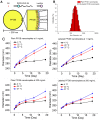Perfluorocarbon nanodroplets can reoxygenate hypoxic tumors in vivo without carbogen breathing
- PMID: 31008022
- PMCID: PMC6470341
- DOI: 10.7150/ntno.29908
Perfluorocarbon nanodroplets can reoxygenate hypoxic tumors in vivo without carbogen breathing
Abstract
Nanoscale perfluorocarbon (PFC) droplets have enormous potential as clinical theranostic agents. They are biocompatible and are currently used in vivo as contrast agents for a variety of medical imaging modalities, including ultrasound, computed tomography, photoacoustic and 19F-magnetic resonance imaging. PFC nanodroplets can also carry molecular and nanoparticulate drugs and be activated in situ by ultrasound or light for targeted therapy. Recently, there has been renewed interest in using PFC nanodroplets for hypoxic tumor reoxygenation towards radiosensitization based on the high oxygen solubility of PFCs. Previous studies showed that tumor oxygenation using PFC agents only occurs in combination with enhanced oxygen breathing. However, recent studies suggest that PFC agents that accumulate in solid tumors can contribute to radiosensitization, presumably due to tumor reoxygenation without enhanced oxygen breathing. In this study, we quantify the impact of oxygenation due to PFC nanodroplet accumulation in tumors alone in comparison with other reoxygenation methodologies, in particular, carbogen breathing. Methods: Lipid-stabilized, PFC (i.e., perfluorooctyl bromide, CF3(CF2)7Br, PFOB) nanoscale droplets were synthesized and evaluated in xenograft prostate (DU145) tumors in male mice. Biodistribution assessment of the nanodroplets was achieved using a fluorescent lipophilic indocarbocyanine dye label (i.e., DiI dye) on the lipid shell in combination with fluorescence imaging in mice (n≥3 per group). Hypoxia reduction in tumors was measured using PET imaging and a known hypoxia radiotracer, [18F]FAZA (n≥ 3 per group). Results: Lipid-stabilized nanoscale PFOB emulsions (mean diameter of ~250 nm), accumulated in the xenograft prostate tumors in mice 24 hours post-injection. In vivo PET imaging with [18F]FAZA showed that the accumulation of the PFOB nanodroplets in the tumor tissues alone significantly reduced tumor hypoxia, without enhanced oxygen (i.e., carbogen) breathing. This reoxygenation effect was found to be comparable with carbogen breathing alone. Conclusion: Accumulation of nanoscale PFOB agents in solid tumors alone successfully reoxygenated hypoxic tumors to levels comparable with carbogen breathing alone, an established tumor oxygenation method. This study confirms that PFC agents can be used to reoxygenate hypoxic tumors in addition to their current applications as multifunctional theranostic agents.
Keywords: PET imaging; nanodroplets; perfluorocarbon; reoxygenation; tumor hypoxia.
Conflict of interest statement
Competing Interests: The authors have declared that no competing interest exists.
Figures



Similar articles
-
18F-Labeled perfluorocarbon droplets for positron emission tomography imaging.Nucl Med Biol. 2017 Nov;54:27-33. doi: 10.1016/j.nucmedbio.2017.07.001. Epub 2017 Jul 12. Nucl Med Biol. 2017. PMID: 28863330
-
Overcoming hypoxia-induced chemoresistance to cisplatin through tumor oxygenation monitored by optical imaging.Nanotheranostics. 2019 May 22;3(2):223-235. doi: 10.7150/ntno.35935. eCollection 2019. Nanotheranostics. 2019. PMID: 31183316 Free PMC article.
-
Perfluorocarbon emulsions radiosensitise brain tumors in carbogen breathing mice with orthotopic GL261 gliomas.PLoS One. 2017 Sep 5;12(9):e0184250. doi: 10.1371/journal.pone.0184250. eCollection 2017. PLoS One. 2017. PMID: 28873460 Free PMC article.
-
Functional ultrasound-triggered phase-shift perfluorocarbon nanodroplets for cancer therapy.Ultrasound Med Biol. 2021 Aug;47(8):2064-2079. doi: 10.1016/j.ultrasmedbio.2021.04.003. Epub 2021 May 13. Ultrasound Med Biol. 2021. PMID: 33992473 Review.
-
Perfluorocarbons: A perspective of theranostic applications and challenges.Front Bioeng Biotechnol. 2023 Aug 3;11:1115254. doi: 10.3389/fbioe.2023.1115254. eCollection 2023. Front Bioeng Biotechnol. 2023. PMID: 37600314 Free PMC article. Review.
Cited by
-
Development of Perfluoro Decalin/Fluorinated Polyimide Core-Shell Microparticles via SPG Membrane Emulsification Using Methyl Perfluoropropyl Ether Cosolvent.ACS Omega. 2024 May 3;9(19):21127-21135. doi: 10.1021/acsomega.4c00897. eCollection 2024 May 14. ACS Omega. 2024. PMID: 38764690 Free PMC article.
-
Perfluorocarbon-based oxygen carriers: from physics to physiology.Pflugers Arch. 2021 Feb;473(2):139-150. doi: 10.1007/s00424-020-02482-2. Epub 2020 Nov 3. Pflugers Arch. 2021. PMID: 33141239 Free PMC article. Review.
-
Assessing the oxygen scavenging capacity and myocardial gas embolization risk of ultrasonically activated phase shift perfluorobutane droplets.J Mater Chem B. 2025 Jul 30;13(30):9065-9080. doi: 10.1039/d4tb02700k. J Mater Chem B. 2025. PMID: 40405824 Free PMC article.
-
Perfluorocarbon nanodroplet size, acoustic vaporization, and inertial cavitation affected by lipid shell composition in vitro.J Acoust Soc Am. 2022 Oct;152(4):2493. doi: 10.1121/10.0014934. J Acoust Soc Am. 2022. PMID: 36319242 Free PMC article.
-
DNA Nanostructures and DNA-Functionalized Nanoparticles for Cancer Theranostics.Adv Sci (Weinh). 2020 Oct 15;7(23):2001669. doi: 10.1002/advs.202001669. eCollection 2020 Dec. Adv Sci (Weinh). 2020. PMID: 33304747 Free PMC article. Review.
References
-
- Amir N, Green D, Kent J. et al. 18F-Labeled perfluorocarbon droplets for positron emission tomography imaging. Nucl Med Biol. 2017;54:27–33. - PubMed
-
- Thomas C, Riess J, Guichard M. Influence of the 100% w/v perfluorooctyl bromide (PFOB) emulsion dose on tumour radiosensitivity. Int J Radiat Biol. 1991;59:433–445. - PubMed
-
- Yao Y, Zhang M, Liu T. et al. Perfluorocarbon-Encapsulated PLGA-PEG Emulsions as Enhancement Agents for Highly Efficient Reoxygenation to Cell and Organism. ACS Appl Mater Interfaces. 2015;7:18369–18378. - PubMed
-
- Rapoport N, Gao Z, Kennedy A. Multifunctional nanoparticles for combining ultrasonic tumor imaging and targeted chemotherapy. J Natl Cancer Inst. 2007;99:1095–106. - PubMed
Publication types
MeSH terms
Substances
LinkOut - more resources
Full Text Sources
Medical
Miscellaneous

